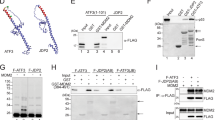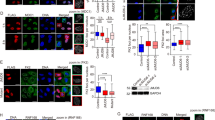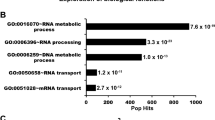Abstract
Rad23 proteins function in both DNA repair and protein stability regulation. As ubiquitinated forms of p53 are stabilized after DNA damage in concert with p53 functional activation, and human Rad23 proteins (hHR23A and B) regulate p53 stability in unstressed cells, the role of hHR23B in post-genotoxin regulation of p53 was investigated. Depletion of hHR23B by specific short interfering RNA before genotoxic exposure attenuated p53, p21 and bax induction, abrogated the accumulation of ubiquitinated p53 and suppressed apoptosis. Expression of ubiquitin derivatives with all lysines mutated except K48 or K63 demonstrated that K48-linked p53-ubiquitin conjugates were specifically induced after DNA damage. hHR23B, along with native and ubiquitinated p53, accumulated in chromatin after genotoxic exposure, and the accumulation of ubiquitinated p53 in chromatin was prevented by hHR23B depletion. Chromatin immunoprecipitation analysis demonstrated that hHR23B and p53 both localized to the p21 promoter shortly after DNA damage. hHR23B thus plays a critical role in the activation and function of p53 after specific genotoxic exposures.
This is a preview of subscription content, access via your institution
Access options
Subscribe to this journal
Receive 50 print issues and online access
$259.00 per year
only $5.18 per issue
Buy this article
- Purchase on Springer Link
- Instant access to full article PDF
Prices may be subject to local taxes which are calculated during checkout




Similar content being viewed by others
References
Brignone C, Bradley KE, Kisselev AF, Grossman SR . (2004). A post-ubiquitination role for MDM2 and hHR23A in the p53 degradation pathway. Oncogene 23: 4121–4129.
Cutts SM, Swift LP, Rephaeli A, Nudelman A, Phillips DR . (2003). Sequence specificity of adriamycin-DNA adducts in human tumor cells. Mol Cancer Ther 2: 661–670.
Glockzin S, Ogi FX, Hengstermann A, Scheffner M, Blattner C . (2003). Involvement of the DNA repair protein hHR23 in p53 degradation. Mol Cell Biol 23: 8960–8969.
Harris SL, Levine AJ . (2005). The p53 pathway: positive and negative feedback loops. Oncogene 24: 2899–2908.
Hsieh HC, Hsieh YH, Huang YH, Shen FC, Tsai HN, Tsai JH et al. (2005). HHR23A, a human homolog of Saccharomyces cerevisiae Rad23, regulates xeroderma pigmentosum C protein and is required for nucleotide excision repair. Biochem Biophys Res Commun 335: 181–187.
Itoh T, Linn S . (2005). The fate of p21CDKN1A in cells surviving UV-irradiation. DNA Repair (Amst) 4: 1457–1462.
Kruczynski A, Barret JM, Van Hille B, Chansard N, Astruc J, Menon Y et al. (2004). Decreased nucleotide excision repair activity and alterations of topoisomerase IIalpha are associated with the in vivo resistance of a P388 leukemia subline to F11782, a novel catalytic inhibitor of topoisomerases I and II. Clin Cancer Res 10: 3156–3168.
Lee YJ, Park SJ, Ciccone SL, Kim CR, Lee SH . (2006). An in vivo analysis of MMC-induced DNA damage and its repair. Carcinogenesis 27: 446–453.
Maki CG, Howley PM . (1997). Ubiquitination of p53 and p21 is differentially affected by ionizing and UV radiation. Mol Cell Biol 17: 355–363.
Muratani M, Tansey WP . (2003). How the ubiquitin–proteasome system controls transcription. Nat Rev Mol Cell Biol 4: 192–201.
Ng JM, Vermeulen W, van der Horst GT, Bergink S, Sugasawa K, Vrieling H et al. (2003). A novel regulation mechanism of DNA repair by damage-induced and RAD23-dependent stabilization of xeroderma pigmentosum group C protein. Genes Dev 17: 1630–1645.
Ng JM, Vrieling H, Sugasawa K, Ooms MP, Grootegoed JA, Vreeburg JT et al. (2002). Developmental defects and male sterility in mice lacking the ubiquitin-like DNA repair gene mHR23B. Mol Cell Biol 22: 1233–1245.
Ortolan TG, Chen L, Tongaonkar P, Madura K . (2004). Rad23 stabilizes Rad4 from degradation by the Ub/proteasome pathway. Nucleic Acids Res 32: 6490–6500.
Pfeifer GP, You YH, Besaratinia A . (2005). Mutations induced by ultraviolet light. Mutat Res 571: 19–31.
Raasi S, Orlov I, Fleming KG, Pickart CM . (2004). Binding of polyubiquitin chains to ubiquitin-associated (UBA) domains of HHR23A. J Mol Biol 341: 1367–1379.
Raasi S, Pickart CM . (2003). Rad23 ubiquitin-associated domains (UBA) inhibit 26 S proteasome-catalysed proteolysis by sequestering lysine 48-linked polyubiquitin chains. J Biol Chem 278: 8951–8959.
Robles AI, Wang XW, Harris CC . (1999). Drug-induced apoptosis is delayed and reduced in XPD lymphoblastoid cell lines: possible role of TFIIH in p53-mediated apoptotic cell death. Oncogene 18: 4681–4688.
Schuler M, Green DR . (2005). Transcription, apoptosis and p53: catch-22. Trends Genet 21: 182–187.
Sdek P, Ying H, Chang DL, Qiu W, Zheng H, Touitou R et al. (2005). MDM2 promotes proteasome-dependent ubiquitin-independent degradation of retinoblastoma protein. Mol Cell 20: 699–708.
Slee EA, O'Connor DJ, Lu X . (2004). To die or not to die: how does p53 decide? Oncogene 23: 2809–2818.
Soria G, Podhajcer O, Prives C, Gottifredi V . (2006). P21Cip1/WAF1 downregulation is required for efficient PCNA ubiquitination after UV irradiation. Oncogene 25: 2829–2838.
Sweder K, Madura K . (2002). Regulation of repair by the 26S proteasome. J Biomed Biotechnol 2: 94–105.
Szak ST, Mays D, Pietenpol JA . (2001). Kinetics of p53 binding to promoter sites in vivo. Mol Cell Biol 21: 3375–3386.
Verma R, Oania R, Graumann J, Deshaies RJ . (2004). Multiubiquitin chain receptors define a layer of substrate selectivity in the ubiquitin–proteasome system. Cell 118: 99–110.
Wang JA, Fan S, Yuan RQ, Ma YX, Meng Q, Goldberg ID et al. (1999). Ultraviolet radiation down-regulates expression of the cell-cycle inhibitor p21WAF1/CIP1 in human cancer cells independently of p53. Int J Radiat Biol 75: 301–316.
Wang Q, Goh AM, Howley PM, Walters KJ . (2003). Ubiquitin recognition by the DNA repair protein hHR23a. Biochemistry 42: 13529–13535.
Wertz IE, O'Rourke KM, Zhou H, Eby M, Aravind L, Seshagiri S et al. (2004). De-ubiquitination and ubiquitin ligase domains of A20 downregulate NF-kappaB signalling. Nature 430: 694–699.
Xie Z, Liu S, Zhang Y, Wang Z . (2004). Roles of Rad23 protein in yeast nucleotide excision repair. Nucleic Acids Res 32: 5981–5990.
Acknowledgements
We thank V Sharma for assistance with ChIP assays. This work was supported by CA107532 from NCI.
Author information
Authors and Affiliations
Corresponding author
Additional information
Supplementary Information accompanies the paper on the Oncogene website (http://www.nature.com/ncponc).
Supplementary information
Rights and permissions
About this article
Cite this article
Kaur, M., Pop, M., Shi, D. et al. hHR23B is required for genotoxic-specific activation of p53 and apoptosis. Oncogene 26, 1231–1237 (2007). https://doi.org/10.1038/sj.onc.1209865
Received:
Revised:
Accepted:
Published:
Issue Date:
DOI: https://doi.org/10.1038/sj.onc.1209865



